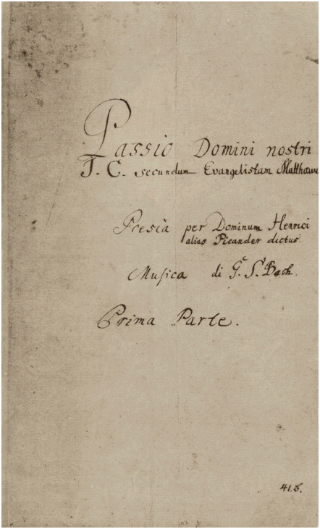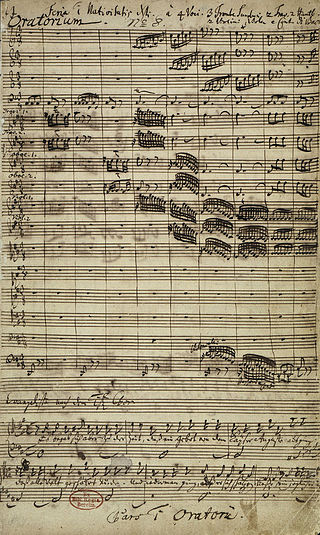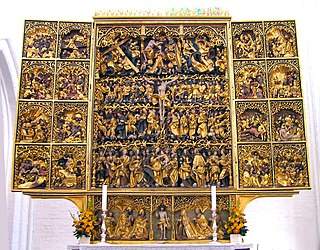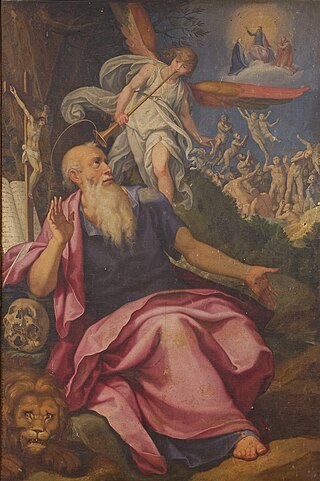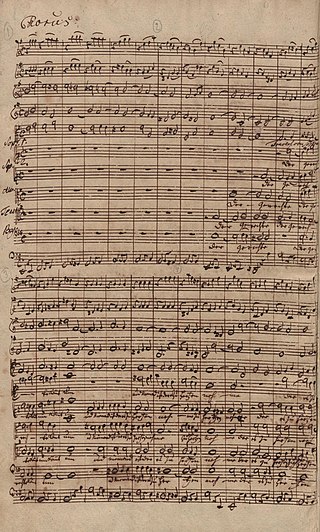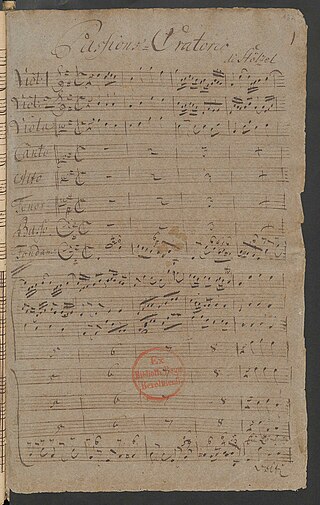Passions composed and/or staged by Bach
According to his " Nekrolog ", the 1754 obituary written by Johann Friedrich Agricola and the composer's son Carl Philipp Emanuel, Bach wrote "five Passions, of which one is for double chorus". [1] The double chorus one is easily identified as the St Matthew Passion. The St John Passion is the only extant other one that is certainly composed by Bach. The libretto of the St Mark Passion was published in Bach's time, allowing reconstruction based on the pieces Bach is known to have parodied for its composition, while the extant St Luke Passion likely contains little or no music composed by Bach. Which Bach compositions, apart from the known ones, may have been meant in the obituary remains uncertain. [2]
The St John Passion is shorter and has simpler orchestration than the St Matthew Passion. The St John Passion has been described as more realistic, faster paced and more anguished than the reflective and resigned St. Matthew Passion.[ citation needed ]
St John Passion
The St John Passion, BWV 245 is the first Passion Bach composed during his tenure as Thomaskantor in Leipzig, a tenure that started after the Easter season of 1723. Apart from the German translation of parts of the Gospel of St John and several Lutheran chorales, it used text of the Brockes Passion for its arias. The Passion was performed on Good Friday of 1724, 1725, 1730 and 1749.
St Matthew Passion
The double chorus St Matthew Passion, BWV 244 was composed on a libretto by Picander for Good Friday of 1727 and/or 1729. After revision the Passion was performed again in 1736 and 1742.
St Luke Passion
Bach's copy of an anonymous St Luke Passion, BWV 246, was published in the Bach Gesellschaft Complete Works (vol. xlv/2) but is regarded as spurious, with the possible exception of the introduction to the second half.
St Mark Passion
Bach wrote the St Mark Passion, BWV 247 for 1731. Picander's libretto for the Passion was once thought to have been destroyed in the bombing of Dresden in World War II, but the recovered copy seems to show that the work was a parody of music from the so-called Trauer-Ode, Laß, Fürstin, laß noch einen Strahl, BWV 198, and that some choruses were used also in the Christmas Oratorio. There are several reconstructions of the Passion.
Other Passions
In his 1802 Bach-biography Johann Nikolaus Forkel repeats what is in the "Nekrolog" regarding the number of Passions composed by Bach. In his 1850 Bach-biography Carl L. Hilgenfeldt attempts to identify all five of the Passions mentioned in the "Nekrolog" and by Forkel. After mentioning the St Matthew, the St John, the St Luke and Picander's libretto of the lost St Mark, Hilgenfeldt mentions a Passion Bach would have composed in 1717, which was the last year Bach was employed in Weimar. [3]
Thus the "fifth" Passion possibly refers to Passion music Bach composed before his tenure as Thomaskantor in Leipzig, parts of which may have been recuperated in his extant Passions. [4] It may also refer to one of the Passion oratorio pasticcios Bach was involved in and/or to a setting of Picander's Erbauliche Gedanken auf den Grünen Donnerstag und Charfreitag über den Leidenden Jesum, published in 1725. [5]
Weimarer Passion
Weimarer Passion , BWV deest, BC D 1, refers to the 1717 Passion mentioned by Hilgenfeldt. It appears to have been performed at the court in Gotha on Good Friday 26 March 1717. Bach appears to have recuperated some of its material in later compositions, notably in his St John Passion. [6]
Jesus Christus ist um unsrer Missetat willen verwundet
In the early 1710s Bach staged Jesus Christus ist um unsrer Missetat willen verwundet , a St Mark Passion, in Weimar. [7] Bach added some of his own chorale settings to that Passion which was probably composed by Gottfried Keiser [7] (older attributions of the original work are to Reinhard Keiser, Gottfried's son, and later to Friedrich Nicolaus Brauns). [8] This Weimar version is known as BC 5a. [7]
He staged a new version of this St Mark Passion pasticcio, BC 5b, in Leipzig in 1726, [9] and finally, expanded with some arias from Handel's Brockes Passion , again in the last years of his life (BNB I/K/2). [8] [10]
Erbauliche Gedanken auf den Grünen Donnerstag und Charfreitag über den Leidenden Jesum
The Passion text included in Picander's Sammlung Erbaulicher Gedanken was published around the time (or shortly before) Bach started his collaboration with this librettist. Bach used six parts of this Passion libretto in his St Matthew Passion, but there is no indication he set anything else of this libretto. As such the Passion libretto was classified among the works spuriously attributed to Bach in the Anhang (Appendix) of the Bach-Werke-Verzeichnis, as BWV Anh. 169. [11]
Wer ist der, so von Edom kömmt
Wer ist der, so von Edom kömmt , a pasticcio Passion oratorio possibly compiled by Bach's son-in-law Johann Christoph Altnickol, contains a few movements attributed to Bach, including the arioso for bass BWV 1088, and Der Gerechte kömmt um (an arrangement of a SSATB motet attributed to Johann Kuhnau). The pasticcio may have been performed in Leipzig in the late 1740s and/or the early 1750s. [12]
Stölzel's Ein Lämmlein geht und trägt die Schuld

Bach performed Gottfried Heinrich Stölzel's Die leidende und am Creutz sterbende Liebe Jesu on Good Friday of 1734. This Passion oratorio, composed for Gotha in 1720, is also known after the incipit of its opening chorus, a setting of Paul Gerhardt's "Ein Lämmlein geht und trägt die Schuld". Bach arranged one of its arias, "Dein Kreuz, o Bräutgam meiner Seelen", as Bekennen will ich seinen Namen, BWV 200. This arrangement, dated around 1742–1743, was possibly part of a cantata for the feast of Purification of the Virgin Mary. [14] [15] [16] [17] [18] [19] [20] [21] [22]
Graun's passion-oratorios (or passion-cantatas)
Bach also knew a few passion-oratorios composed by Carl Heinrich Graun. He performed Graun's Ein Lämmlein geht und trägt die Schuld sometime in the 1730s-1740s, and even had a copy of the score in his library. The same with his "Great Passion" Kommt her und schaut . [23]
Telemann's passion-oratorios
Bach also knew of a few passion-oratorios by Georg Philipp Telemann (his friend and Godfather to Carl Philipp Emanuel). In addition to Telemann's Brockes Passion , there is evidence that Bach performed the original (Hamburg) version of his ''Seliges Erwägen des Leidens und Sterbens Jesu Christi'' TWV 5:2a between 1732 and 1735. [24]
Handel's passion-oratorio
Bach also knew of George Frideric Handel's setting of the Passion text by Barthold Heinrich Brockes ( Brockes Passion ). This is exemplified by a manuscript copy by Bach and one of his principal copyists dating from 1746 to 1748. Bach is known to have performed this work on Good Friday 1746, and used 7 arias from it in his last Passion-Pasticcio on the Hamburg St. Mark Passion (BNB I/K/2).
